Project Management: Assessing Progress, Strategies, and Processes
VerifiedAdded on 2023/04/08
|6
|874
|458
Report
AI Summary
This report provides a detailed overview of key aspects of project management. It begins by outlining essential organisational policies, practices, and procedures related to human resources, physical resource acquisition, intellectual property protection, plan variations, and performance monitoring. The report then discusses strategies and processes for acquiring necessary resources, emphasizing the importance of vendor selection and material quality. Finally, it details strategies and processes for assessing project progress, highlighting the use of KPIs, supervisor reporting, and regular performance analysis to ensure projects stay on track and achieve desired outcomes. This student contributed assignment is available on Desklib, a platform offering a wealth of study resources for students.
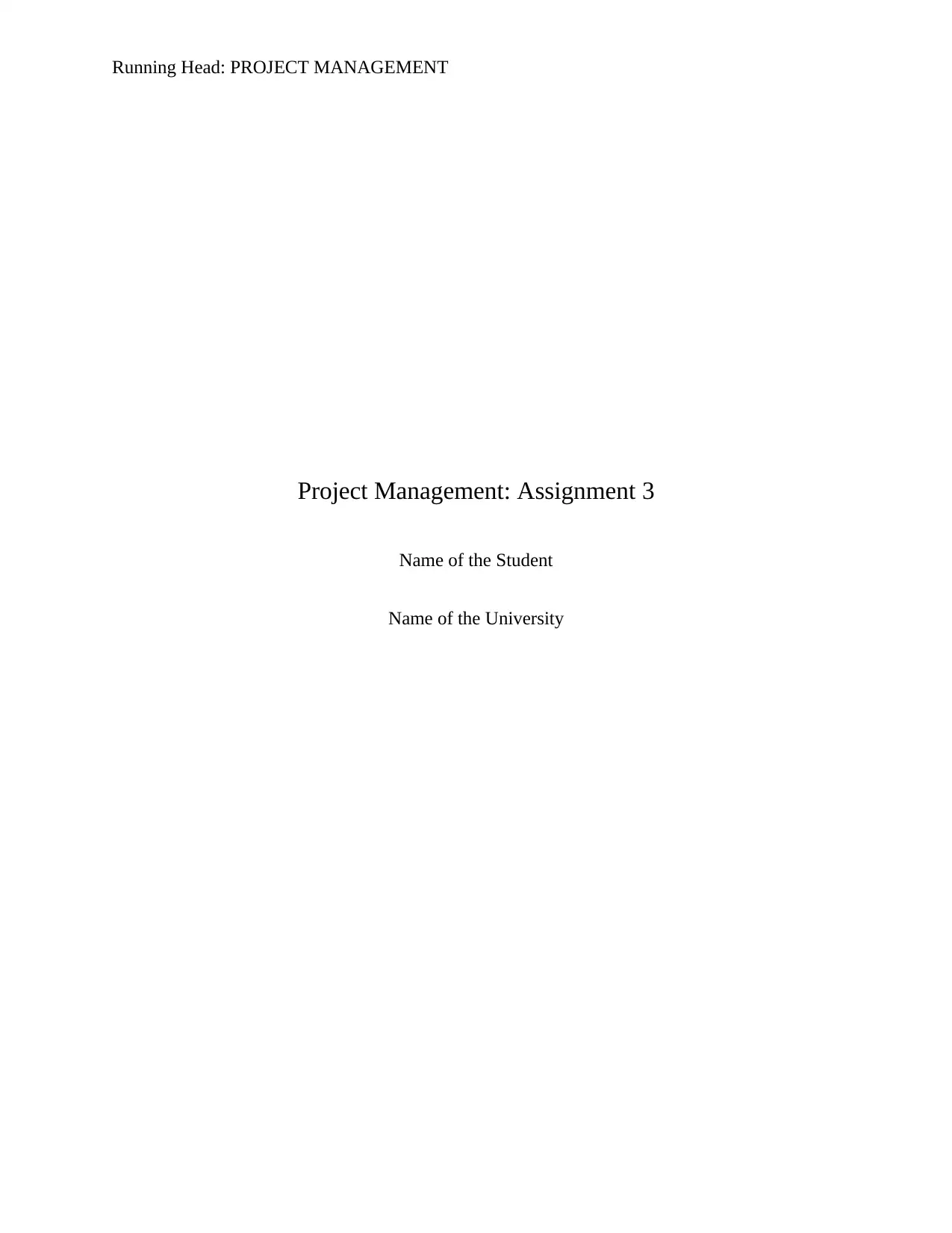
Running Head: PROJECT MANAGEMENT
Project Management: Assignment 3
Name of the Student
Name of the University
Project Management: Assignment 3
Name of the Student
Name of the University
Paraphrase This Document
Need a fresh take? Get an instant paraphrase of this document with our AI Paraphraser
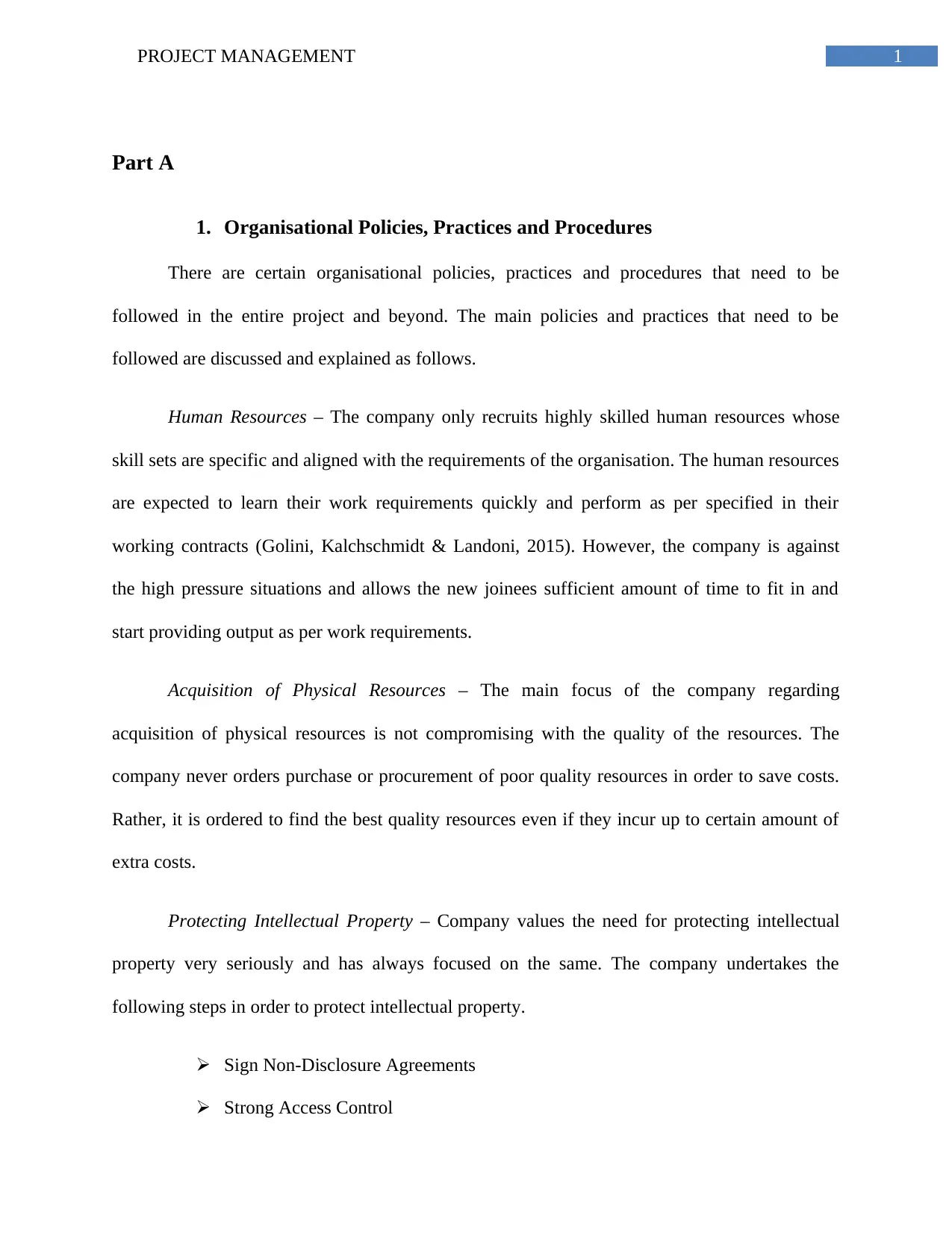
1PROJECT MANAGEMENT
Part A
1. Organisational Policies, Practices and Procedures
There are certain organisational policies, practices and procedures that need to be
followed in the entire project and beyond. The main policies and practices that need to be
followed are discussed and explained as follows.
Human Resources – The company only recruits highly skilled human resources whose
skill sets are specific and aligned with the requirements of the organisation. The human resources
are expected to learn their work requirements quickly and perform as per specified in their
working contracts (Golini, Kalchschmidt & Landoni, 2015). However, the company is against
the high pressure situations and allows the new joinees sufficient amount of time to fit in and
start providing output as per work requirements.
Acquisition of Physical Resources – The main focus of the company regarding
acquisition of physical resources is not compromising with the quality of the resources. The
company never orders purchase or procurement of poor quality resources in order to save costs.
Rather, it is ordered to find the best quality resources even if they incur up to certain amount of
extra costs.
Protecting Intellectual Property – Company values the need for protecting intellectual
property very seriously and has always focused on the same. The company undertakes the
following steps in order to protect intellectual property.
Sign Non-Disclosure Agreements
Strong Access Control
Part A
1. Organisational Policies, Practices and Procedures
There are certain organisational policies, practices and procedures that need to be
followed in the entire project and beyond. The main policies and practices that need to be
followed are discussed and explained as follows.
Human Resources – The company only recruits highly skilled human resources whose
skill sets are specific and aligned with the requirements of the organisation. The human resources
are expected to learn their work requirements quickly and perform as per specified in their
working contracts (Golini, Kalchschmidt & Landoni, 2015). However, the company is against
the high pressure situations and allows the new joinees sufficient amount of time to fit in and
start providing output as per work requirements.
Acquisition of Physical Resources – The main focus of the company regarding
acquisition of physical resources is not compromising with the quality of the resources. The
company never orders purchase or procurement of poor quality resources in order to save costs.
Rather, it is ordered to find the best quality resources even if they incur up to certain amount of
extra costs.
Protecting Intellectual Property – Company values the need for protecting intellectual
property very seriously and has always focused on the same. The company undertakes the
following steps in order to protect intellectual property.
Sign Non-Disclosure Agreements
Strong Access Control
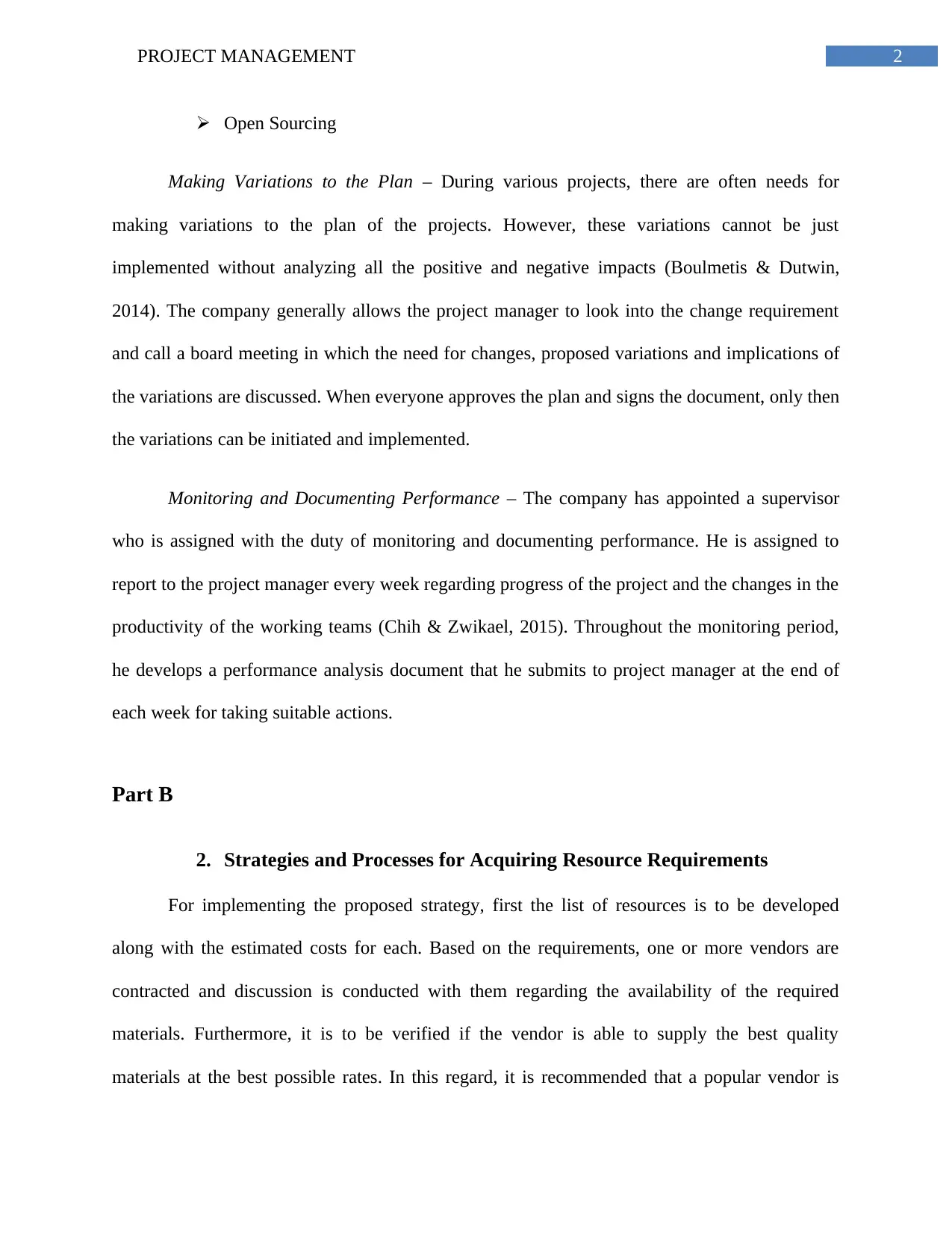
2PROJECT MANAGEMENT
Open Sourcing
Making Variations to the Plan – During various projects, there are often needs for
making variations to the plan of the projects. However, these variations cannot be just
implemented without analyzing all the positive and negative impacts (Boulmetis & Dutwin,
2014). The company generally allows the project manager to look into the change requirement
and call a board meeting in which the need for changes, proposed variations and implications of
the variations are discussed. When everyone approves the plan and signs the document, only then
the variations can be initiated and implemented.
Monitoring and Documenting Performance – The company has appointed a supervisor
who is assigned with the duty of monitoring and documenting performance. He is assigned to
report to the project manager every week regarding progress of the project and the changes in the
productivity of the working teams (Chih & Zwikael, 2015). Throughout the monitoring period,
he develops a performance analysis document that he submits to project manager at the end of
each week for taking suitable actions.
Part B
2. Strategies and Processes for Acquiring Resource Requirements
For implementing the proposed strategy, first the list of resources is to be developed
along with the estimated costs for each. Based on the requirements, one or more vendors are
contracted and discussion is conducted with them regarding the availability of the required
materials. Furthermore, it is to be verified if the vendor is able to supply the best quality
materials at the best possible rates. In this regard, it is recommended that a popular vendor is
Open Sourcing
Making Variations to the Plan – During various projects, there are often needs for
making variations to the plan of the projects. However, these variations cannot be just
implemented without analyzing all the positive and negative impacts (Boulmetis & Dutwin,
2014). The company generally allows the project manager to look into the change requirement
and call a board meeting in which the need for changes, proposed variations and implications of
the variations are discussed. When everyone approves the plan and signs the document, only then
the variations can be initiated and implemented.
Monitoring and Documenting Performance – The company has appointed a supervisor
who is assigned with the duty of monitoring and documenting performance. He is assigned to
report to the project manager every week regarding progress of the project and the changes in the
productivity of the working teams (Chih & Zwikael, 2015). Throughout the monitoring period,
he develops a performance analysis document that he submits to project manager at the end of
each week for taking suitable actions.
Part B
2. Strategies and Processes for Acquiring Resource Requirements
For implementing the proposed strategy, first the list of resources is to be developed
along with the estimated costs for each. Based on the requirements, one or more vendors are
contracted and discussion is conducted with them regarding the availability of the required
materials. Furthermore, it is to be verified if the vendor is able to supply the best quality
materials at the best possible rates. In this regard, it is recommended that a popular vendor is
⊘ This is a preview!⊘
Do you want full access?
Subscribe today to unlock all pages.

Trusted by 1+ million students worldwide
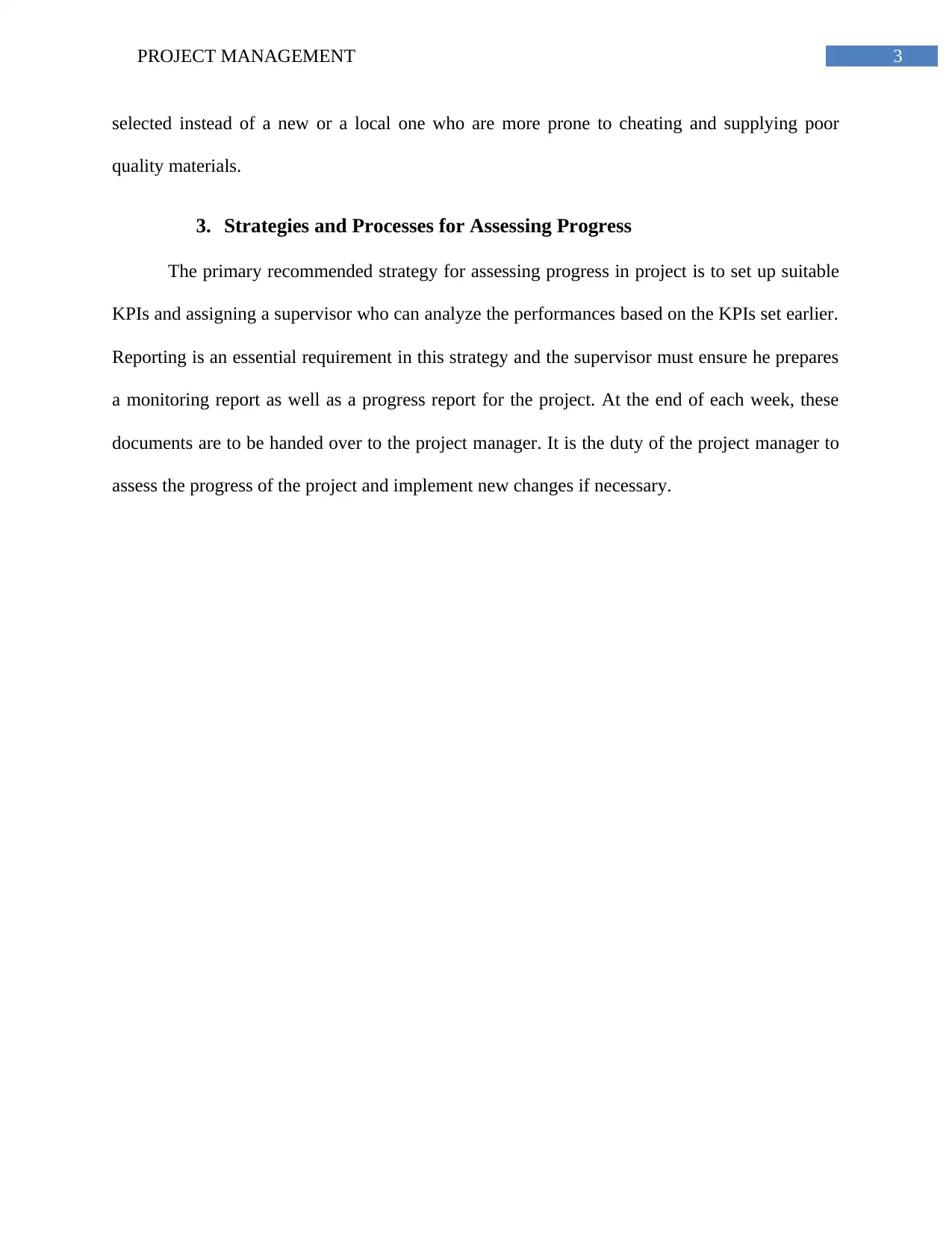
3PROJECT MANAGEMENT
selected instead of a new or a local one who are more prone to cheating and supplying poor
quality materials.
3. Strategies and Processes for Assessing Progress
The primary recommended strategy for assessing progress in project is to set up suitable
KPIs and assigning a supervisor who can analyze the performances based on the KPIs set earlier.
Reporting is an essential requirement in this strategy and the supervisor must ensure he prepares
a monitoring report as well as a progress report for the project. At the end of each week, these
documents are to be handed over to the project manager. It is the duty of the project manager to
assess the progress of the project and implement new changes if necessary.
selected instead of a new or a local one who are more prone to cheating and supplying poor
quality materials.
3. Strategies and Processes for Assessing Progress
The primary recommended strategy for assessing progress in project is to set up suitable
KPIs and assigning a supervisor who can analyze the performances based on the KPIs set earlier.
Reporting is an essential requirement in this strategy and the supervisor must ensure he prepares
a monitoring report as well as a progress report for the project. At the end of each week, these
documents are to be handed over to the project manager. It is the duty of the project manager to
assess the progress of the project and implement new changes if necessary.
Paraphrase This Document
Need a fresh take? Get an instant paraphrase of this document with our AI Paraphraser
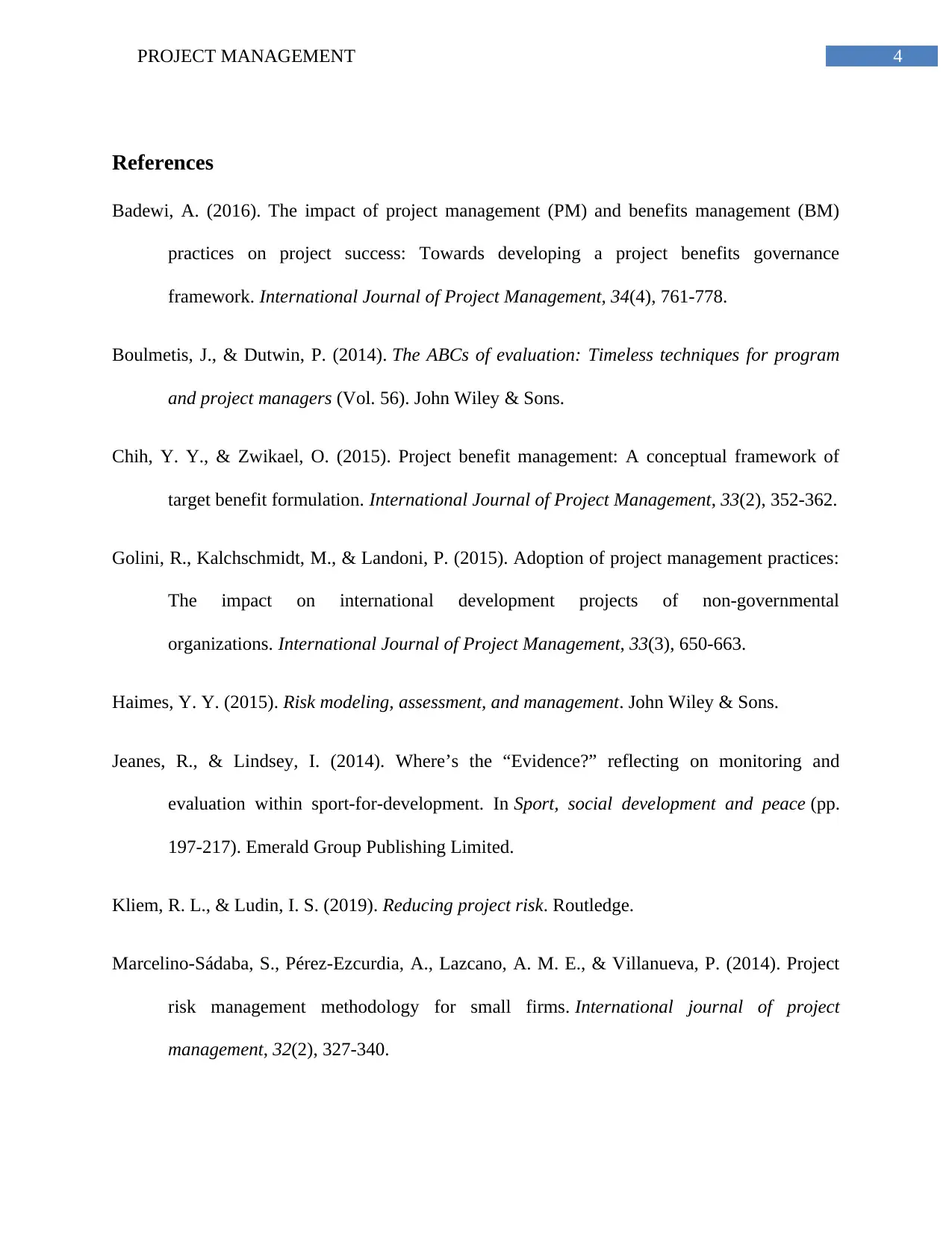
4PROJECT MANAGEMENT
References
Badewi, A. (2016). The impact of project management (PM) and benefits management (BM)
practices on project success: Towards developing a project benefits governance
framework. International Journal of Project Management, 34(4), 761-778.
Boulmetis, J., & Dutwin, P. (2014). The ABCs of evaluation: Timeless techniques for program
and project managers (Vol. 56). John Wiley & Sons.
Chih, Y. Y., & Zwikael, O. (2015). Project benefit management: A conceptual framework of
target benefit formulation. International Journal of Project Management, 33(2), 352-362.
Golini, R., Kalchschmidt, M., & Landoni, P. (2015). Adoption of project management practices:
The impact on international development projects of non-governmental
organizations. International Journal of Project Management, 33(3), 650-663.
Haimes, Y. Y. (2015). Risk modeling, assessment, and management. John Wiley & Sons.
Jeanes, R., & Lindsey, I. (2014). Where’s the “Evidence?” reflecting on monitoring and
evaluation within sport-for-development. In Sport, social development and peace (pp.
197-217). Emerald Group Publishing Limited.
Kliem, R. L., & Ludin, I. S. (2019). Reducing project risk. Routledge.
Marcelino-Sádaba, S., Pérez-Ezcurdia, A., Lazcano, A. M. E., & Villanueva, P. (2014). Project
risk management methodology for small firms. International journal of project
management, 32(2), 327-340.
References
Badewi, A. (2016). The impact of project management (PM) and benefits management (BM)
practices on project success: Towards developing a project benefits governance
framework. International Journal of Project Management, 34(4), 761-778.
Boulmetis, J., & Dutwin, P. (2014). The ABCs of evaluation: Timeless techniques for program
and project managers (Vol. 56). John Wiley & Sons.
Chih, Y. Y., & Zwikael, O. (2015). Project benefit management: A conceptual framework of
target benefit formulation. International Journal of Project Management, 33(2), 352-362.
Golini, R., Kalchschmidt, M., & Landoni, P. (2015). Adoption of project management practices:
The impact on international development projects of non-governmental
organizations. International Journal of Project Management, 33(3), 650-663.
Haimes, Y. Y. (2015). Risk modeling, assessment, and management. John Wiley & Sons.
Jeanes, R., & Lindsey, I. (2014). Where’s the “Evidence?” reflecting on monitoring and
evaluation within sport-for-development. In Sport, social development and peace (pp.
197-217). Emerald Group Publishing Limited.
Kliem, R. L., & Ludin, I. S. (2019). Reducing project risk. Routledge.
Marcelino-Sádaba, S., Pérez-Ezcurdia, A., Lazcano, A. M. E., & Villanueva, P. (2014). Project
risk management methodology for small firms. International journal of project
management, 32(2), 327-340.
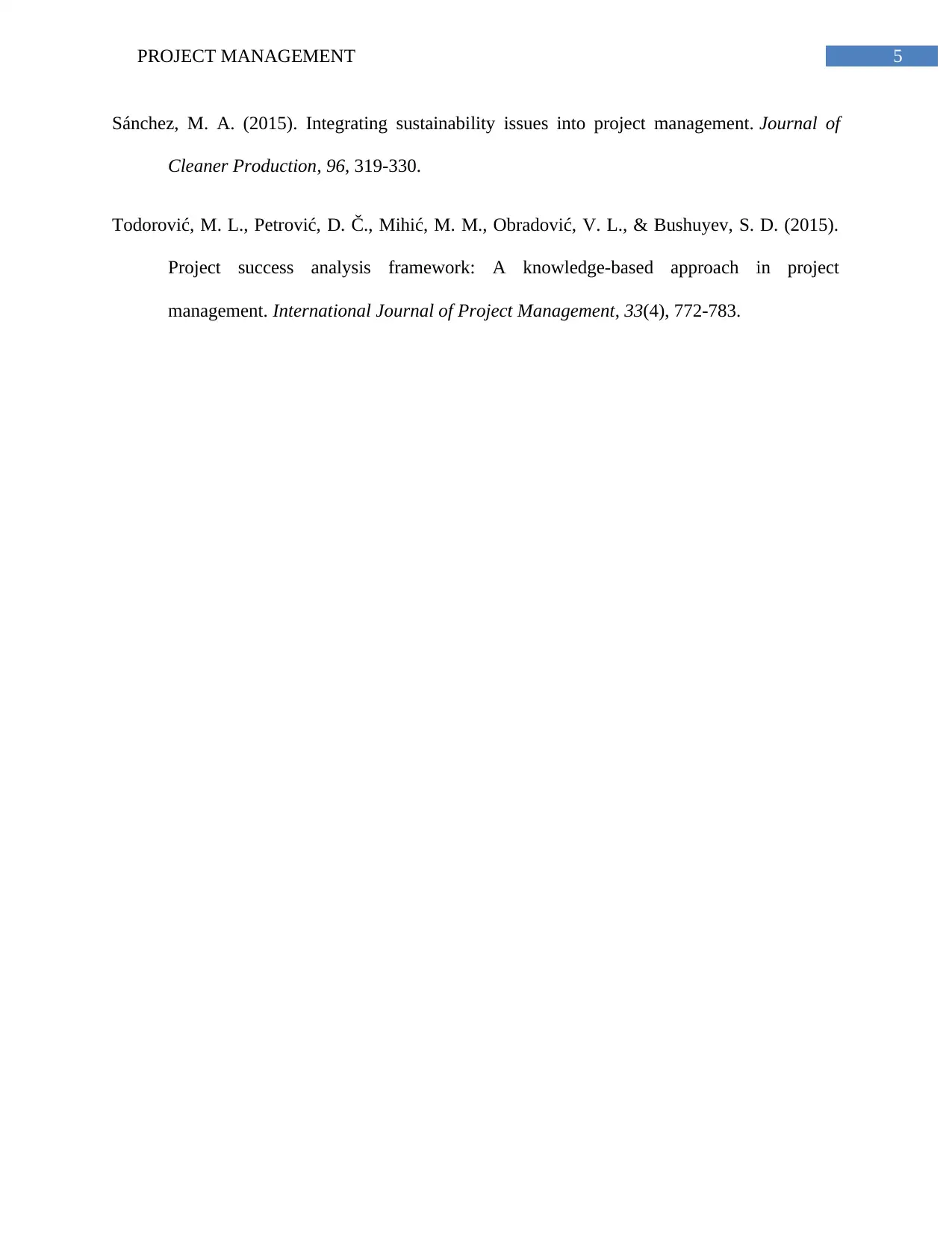
5PROJECT MANAGEMENT
Sánchez, M. A. (2015). Integrating sustainability issues into project management. Journal of
Cleaner Production, 96, 319-330.
Todorović, M. L., Petrović, D. Č., Mihić, M. M., Obradović, V. L., & Bushuyev, S. D. (2015).
Project success analysis framework: A knowledge-based approach in project
management. International Journal of Project Management, 33(4), 772-783.
Sánchez, M. A. (2015). Integrating sustainability issues into project management. Journal of
Cleaner Production, 96, 319-330.
Todorović, M. L., Petrović, D. Č., Mihić, M. M., Obradović, V. L., & Bushuyev, S. D. (2015).
Project success analysis framework: A knowledge-based approach in project
management. International Journal of Project Management, 33(4), 772-783.
⊘ This is a preview!⊘
Do you want full access?
Subscribe today to unlock all pages.

Trusted by 1+ million students worldwide
1 out of 6
Related Documents
Your All-in-One AI-Powered Toolkit for Academic Success.
+13062052269
info@desklib.com
Available 24*7 on WhatsApp / Email
![[object Object]](/_next/static/media/star-bottom.7253800d.svg)
Unlock your academic potential
Copyright © 2020–2025 A2Z Services. All Rights Reserved. Developed and managed by ZUCOL.





